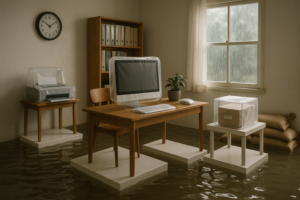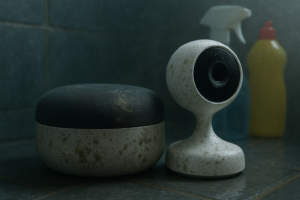Bee Cave Learns the Truth About Black Mold
Don't Let Black Mold Lie to You
Stachybotrys Chartarum, commonly referred to as black mold, is a filamentous fungus belonging to the class Ascomycetes. This mold species is characterized by its dark black appearance with a green hue, attributed to the pigmentation of its conidia and conidiophores.
The optimal conditions for the growth of Stachybotrys Chartarum include high humidity levels, typically exceeding 55%, coupled with a cellulose-rich substrate. The mold’s mycotoxins, like trichothecenes, have been implicated in various health issues.
Exposure to mycotoxins produced by Stachybotrys Chartarum has been associated with respiratory distress, skin irritation, neurological ailments, and even death.
These toxins act through diverse mechanisms, including inhibition of protein synthesis and interference with cellular processes. Individuals with compromised immune systems are especially vulnerable and may experience heightened sensitivity to these mycotoxins.
Is Black Mold Impacting Your Neighborhood?
The Falconhead, Ladera, and Bella Colinas neighborhoods experience elevated humidity levels due to the proximity of lakes, this increases the potential for the growth of Stachybotrys Chartarum.
Similarly, in the Uplands, The Grove, and Homestead communities, the presence of cellulose-rich substrates and lush landscapes create conditions conducive to mold growth.
Meadow Fox, Wildwood, and Canyonside are areas with diverse flora, where residents should be vigilant about managing moisture in their homes, as mold tends to thrive in such environments.
In Lakes Edge, Signal Hill, and Creeks Edge, proximity to water bodies and elevated terrain impact humidity levels, residents should implement effective moisture control measures to mitigate the risk of Stachybotrys Chartarum growth.
For East Village and Twin Acres, the new housing structures change airflow and ventilation, homeowners should pay attention to proper ventilation to prevent mold issues.
Featured Questions
Frequently Ask Questions
Get the answers about black mold you’ve been searching for
Exposure to black mold and its mycotoxins can lead to various health issues. The severity of reactions can vary among individuals.
Especially vulnerable people with compromised immune systems are more susceptible to the effects of mold exposure.
Symptoms of black mold exposure include:
- Coughing
- Wheezing
- Fever
- Tightness in the chest
- Congestion
- Difficulty breathing
- Insomnia
- Skin irritation
- Rashes
- Hives
- Watery or itchy eyes
- Runny or stuffy nose
- Headaches
- Nausea
- Drowsiness
For every 10 homes in Austin, 1.6 of them have black mold in their air ducts.
It's worth getting your home tested even if those odds aren't extremely high.
If there are visible signs of mold or your family is experiencing mold exposure symptoms, call a mold professional right away.
Many companies will remove mold, but these are the kinds of companies that are most likely to be licensed in mold removal and do it the right way:
- Mold Remediation Companies
- Restoration Companies
- Environmental Consultants
- General Contractors
Always make sure the company you hire is licensed in the state of Texas and has the tools and know-how to take care of your issue.
Schedule Free Assessment
Reach out to our team 24/7 and we'll be in touch shortly
Insight
Latest Articles

Water leaks often catch people off guard. That slow drip under the sink or behind the washing machine can turn into a flooded room in

When you think of “empaths,” who comes to mind? As someone who spent two decades as a pediatric nurse, my first thoughts have always been

Remote work has changed the way people approach jobs and life. More people than ever now rely on productive home office setups for success. Yet,

Smart homes bring comfort, safety, and control to our daily lives. From voice assistants to Wi-Fi cameras and smart speakers, these devices keep things efficient

